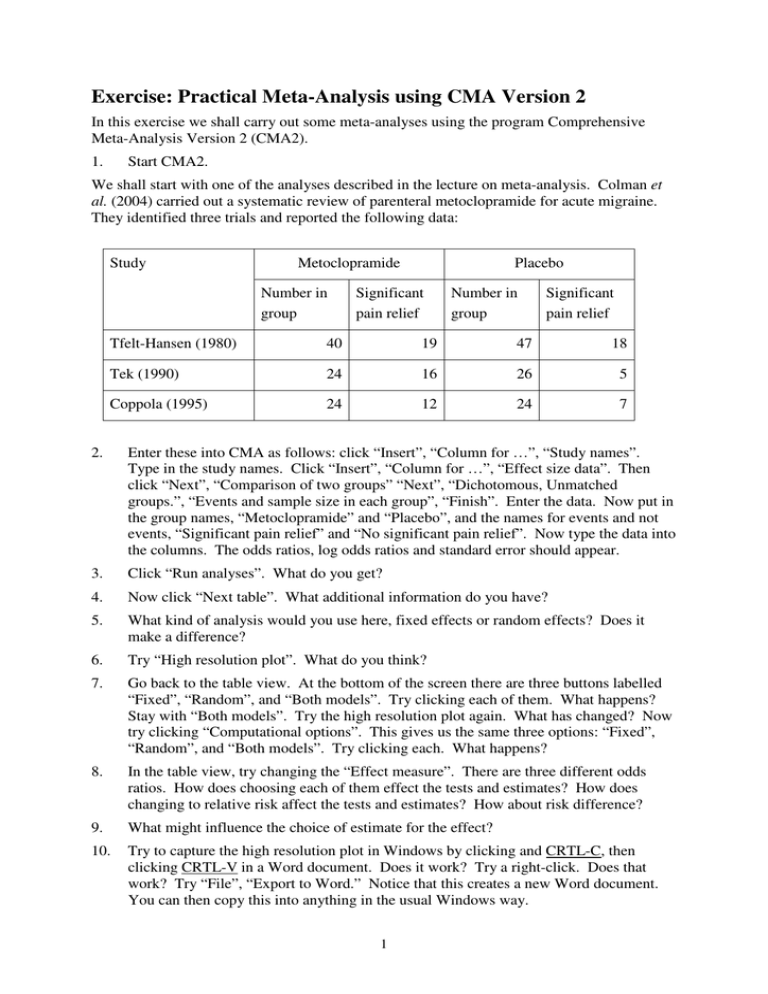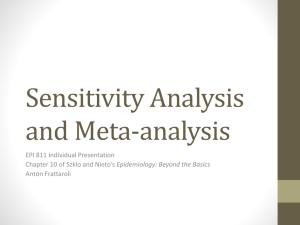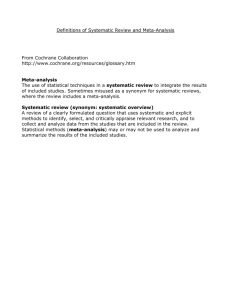Exercise: Practical Meta-Analysis using CMA Version 2
advertisement

Exercise: Practical Meta-Analysis using CMA Version 2 In this exercise we shall carry out some meta-analyses using the program Comprehensive Meta-Analysis Version 2 (CMA2). 1. Start CMA2. We shall start with one of the analyses described in the lecture on meta-analysis. Colman et al. (2004) carried out a systematic review of parenteral metoclopramide for acute migraine. They identified three trials and reported the following data: Study Metoclopramide Number in group Placebo Significant pain relief Number in group Significant pain relief Tfelt-Hansen (1980) 40 19 47 18 Tek (1990) 24 16 26 5 Coppola (1995) 24 12 24 7 2. Enter these into CMA as follows: click “Insert”, “Column for …”, “Study names”. Type in the study names. Click “Insert”, “Column for …”, “Effect size data”. Then click “Next”, “Comparison of two groups” “Next”, “Dichotomous, Unmatched groups.”, “Events and sample size in each group”, “Finish”. Enter the data. Now put in the group names, “Metoclopramide” and “Placebo”, and the names for events and not events, “Significant pain relief” and “No significant pain relief”. Now type the data into the columns. The odds ratios, log odds ratios and standard error should appear. 3. Click “Run analyses”. What do you get? 4. Now click “Next table”. What additional information do you have? 5. What kind of analysis would you use here, fixed effects or random effects? Does it make a difference? 6. Try “High resolution plot”. What do you think? 7. Go back to the table view. At the bottom of the screen there are three buttons labelled “Fixed”, “Random”, and “Both models”. Try clicking each of them. What happens? Stay with “Both models”. Try the high resolution plot again. What has changed? Now try clicking “Computational options”. This gives us the same three options: “Fixed”, “Random”, and “Both models”. Try clicking each. What happens? 8. In the table view, try changing the “Effect measure”. There are three different odds ratios. How does choosing each of them effect the tests and estimates? How does changing to relative risk affect the tests and estimates? How about risk difference? 9. What might influence the choice of estimate for the effect? 10. Try to capture the high resolution plot in Windows by clicking and CRTL-C, then clicking CRTL-V in a Word document. Does it work? Try a right-click. Does that work? Try “File”, “Export to Word.” Notice that this creates a new Word document. You can then copy this into anything in the usual Windows way. 1 Now try it without my help. The next table shows results from a systematic review of comparing low concentration epidural infusions with opioid analgesia during delivery (Liu and Sia, 2004), also included in the lecture on meta-analysis. The outcome variable is Caesarean section. Study Epidural Caesarean Opioid Total Caesarean Total Bofill et al. 1997 5 49 3 51 Clark et al. 1998 15 156 22 162 Dickinson et al. 2002 85 493 71 499 Loughnan et al. 2000 36 304 40 310 Sharma et al. 1997 9 197 11 189 Sharma et al. 2002 16 226 20 233 Thorp et al. 1993 12 48 1 45 11. Enter the data in CMA and carry out a meta-analysis. 12. Compare this to the analysis published in the BMJ: Do you get the same answer? If you didn’t, how does yours differ? 2 Now try this one, which we haven’t seen before. Gøtzsche and Johansen (1998) reported a meta-analysis of short term low dose prednisolone versus placebo in rheumatoid arthritis. The following table compares mean grip strength (mm Hg). Study Prednisolone Mean SD Placebo Number Mean SD Number Boardman 1967 372 85 13 299 85 13 Dick 1980 213 136 24 149 115 24 Gestel 1995 191 112 20 160 160 20 Jasani 1968 356 151 8 267 267 8 Lee 1973 109 47 21 97 97 21 Lee 1974 73.1 43.5 18 59.2 59.2 18 These data are available as a Word file, stored on the disk as Gotzsche.doc. 13. Enter the data by extracting them from the Word file. This time, after you choose “Compare two groups” you will need to choose “Continuous (Means)”, “Unmatched groups, post data only” and “Mean, SD, and sample size in each group”. This creates columns for all these, plus an extra column labelled “Effect direction”. In Word, highlight the table columns, excluding the heading rows. Click CTRL-C. Highlight the first cell of the CMA spreadsheet and click CTRL-V. The extra column labelled “Effect direction” would be useful if we had our variables specified in different units. For example, a reaction time test might be reported as time to do a task in one study and speed at which a task was done in another. We could put the data in as they stand and tell the program that one difference was negative and the other positive. For the grip strength analysis the variables are all the same, so we can choose “Auto”. 14. Carry out a meta-analysis. 15. Try changing the “Effect measure” from “Standardised difference in means” to “Difference in means”. What happens? Adjust the scale of the forest plot using “Format”. (Hint: you will need to insert your own “Customized scale”). 16. Why is there no difference between the results of the fixed effects analysis and the random effects analysis? (I think this is wrong. Why might it be wrong?) 3 The following table shows the results of a systematic review of the effect on birthweight of passive smoking during pregnancy by non-smoking mothers (Peacock et al., 1998) which we looked at in the exercise on publication bias. Study Number of births Difference in mean birth weight, nonpassive-smokers minus passive smokers Rubin et al. (1986) * 500 Martin and Bracken (1986) 2473 Haddow et al. (1988) * 1231 Lazzaroni et al. (1990) 647 Ogawa et al. (1991) 5336 Mathai et al. (1992) 994 Zhang and Radcliffe (1993) 1785 Martinez et al. (1994) 907 Mainous and Hueston (1994) 1173 Eskenazi et al. (1995) 2243 Peacock et al. (1998) 818 * Estimates recalculated from the original papers 60g 24g 108g 38g 11g 63g 30g 34g 84g 45g 6.7g 95% confidence interval for difference −33 to 153g −13 to 60g 49 to 167g −31 to 107g −11 to 32g 12 to 114g −7 to 66g 5 to 63g 15 to 153g −36 to 125 −84 to 97 17. Enter the data in CMA and carry out a meta-analysis. (Hint: try “Generic point estimates” and “Computed effect sizes”. You will need to put “0.95” in “Confidence level”.) What is your estimate of the effect of passive smoking on birthweight? 18. Is there any evidence of publication bias? (Hint: try “Analyses”, “Publication bias” and then try “Table” and “Next table”.) 19. What is the effect on the estimate of using the trim and fill method? (Hint: try “Plot observed . . .”.) 20. Try storing this data file using “File”, clearing the memory, and bringing the file back. You need enter data only once. CMA version 2 is a powerful meta-analysis program. You can enter data in many formats and you can enter different formats for the same meta-analysis. It will almost certainly do all the meta-analytical calculations you need for a Master’s dissertation. CMA2 has one serious downside. Output is a problem. There is no continuous recording of results as with SPSS, or log file function as with Stata. We can print the results screen by clicking "File", "Print". This sends the results to the default printer of the computer. We can choose any of the installed print devices using "Print set-up". This might include output "devices" such as a PDF printer. You can write to a PDF file using this, but must set up a new file for each page of output. In the computer classroom A/E/004, the following work: • Microsoft Office Document Image Writer • Microsoft XPS Document Writer • Send to OneNote 2007 4 Whether you can then take these away and read them elsewhere is something you will have to decide. Microsoft Office Document Image Writer produces a TIF file, a graphic image which Word will read, but it is not text. Microsoft XPS Document Writer produces a file which a web browser can read. Getting your data into text form from either of these is fiddly. I couldn' t read the OneNote file on my own computer. The following don' t work, but crash CMA. You will lose any unsaved data: • Scansoft PDF Create • documcom PDF Driver Martin Bland 3 March 2010 References Colman I, Brown MD, Innes GD, Grafstein E, Roberts TE, Rowe BH. (2004) Parenteral metoclopramide for acute migraine: meta-analysis of randomised controlled trials. BMJ 329: 1369-72. Gøtzsche PC, Johansen H-K. (1998) Meta-analysis of short term low dose prednisolone versus placebo and non-steroidal anti-inflammatory drugs in rheumatoid arthritis. BMJ 316: 811-818. Liu EHC, Sia ATH. (2004) Rates of caesarean section and instrumental vaginal delivery in nulliparous women after low concentration epidural infusions or opioid analgesia: systematic review. BMJ 328: 1410-12. Peacock, J.L., Cook, D.G., Carey, I.M., Jarvis, M.J., Bryant, A.E., Anderson, H.R., and Bland, J.M. (1998) Maternal cotinine level during pregnancy and birthweight for gestational age. International Journal of Epidemiology 27, 647-656. 5



